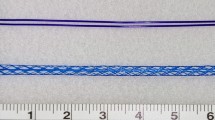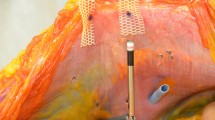Abstract
Background: There are few reports of overall strength of laparoscopic and open incisional hernia repair. Methods: After anesthesia, a 2-inch circular defect was made in the abdominal wall of 28 female swine. Gore-Tex DualMesh Biomaterial (W. L. Gore & Associates, Flagstaff, AZ) was used for all repairs. Sixteen animals underwent open repair and 12 underwent laparoscopic repair. Burst strength was detected within 2 weeks and at 6 weeks by euthanizing the animals and insufflating the abdominal cavity with water while measuring the intraabdominal pressure until it could no longer be pressurized. Results: Three events occurred after insufflation: rupture around patch (R), dissection from insufflation or pressure monitoring sites (D), or rectal prolapse (P). Failure after open early repair occurred at 289 (range 219–388) mmHg with 7-R, 1-P and late 289 (196–343) mmHg with 1-R, 6-P. Failure after laparoscopic early repair occurred at 259 (191–388) mmHg with 4-R, 1-P, 1-D and late 291 (140–330) mmHg with 2-R, 1-P, 3-D. Late groups were less likely to rupture. Conclusion: Both hernia repairs are durable at early and late periods. Tissue ingrowth adds to repair strength. We could not show that one repair was stronger than the other. Nonetheless, laparoscopic repair tended to degrade by dissection, which was our highest pressure event.


Similar content being viewed by others
References
S Bageacu P Blanc C Breton M Gonzales J Porcheron M Chabert JG Balique (2002) ArticleTitleLaparoscopic repair of incisional hernia: a retrospective study of 159 patients. Surg Endosc 16 345–348 Occurrence Handle1:STN:280:DC%2BD383jtVajtQ%3D%3D
JJ Bauer BA Salky M Gelernt I Kreel (1987) ArticleTitleRepair of large abdominal wall defects with expanded polytetraflouroethylene (PTFE). Ann Surg 206 765–769 Occurrence Handle1:STN:280:BieD2snhslU%3D Occurrence Handle3689012
AG Cresswell H Grundstrom A Thorstensson (1992) ArticleTitleObservations on intra-abdominal pressure and patterns of abdominal intra-muscular activity in man. Acta Physiol Scand 144 409–418 Occurrence Handle1:STN:280:By2B1MrovVE%3D Occurrence Handle1534959
AG Cresswell A Thorstensson (1989) ArticleTitleThe role of the abdominal musculature in the elevation of the intra-abdominal pressure during specified tasks. Ergonomics 32 1237–1246 Occurrence Handle1:STN:280:By%2BD1M3gs1A%3D Occurrence Handle2532129
AG Cresswell A Thorstensson (1994) ArticleTitleChanges in intra-abdominal pressure, trunk muscle activation and force during isokinetic lifting and lowering. Eur J Appl Occup Physiol 68 315–321 Occurrence Handle1:STN:280:ByuA3szjtVM%3D
Y-M Dion R Laplante J Charara M Marois (1994) ArticleTitleThe influence of the number of endoclips and of mesh incorporation on the strength of an experimental hernia patch repair. Surg Endosc 8 1324–1328 Occurrence Handle1:STN:280:ByqC3s3pslc%3D Occurrence Handle7831606
R Fernandez Lobato C Martinez Santos P Ortega Deballon JM Fradejas Lopez FJ Marin Lucas M Moreno Azcoita (2001) ArticleTitleColocutaneous fistula due to polypropylene mesh. Hernia 5 107–109 Occurrence Handle11505647
RJ Fitzgibbons Jr AG Greenburg LM Nyhus (2002) Nyhus and Condon’s hernia, 5th ed. Lippincott Williams & Wilkins Philadelphia 368–369
S Grillner J Nilsson A Thorstensson (1978) ArticleTitleIntra-abdominal pressure changes during natural movements in man. Acta Physiol Scand 103 275–283
BT Heniford A Park BJ Ramshaw G Voeller (2000) ArticleTitleLaparoscopic ventral and incisional hernia repair in 407 patients. J Am Coll Surg 190 645–650 Occurrence Handle1:STN:280:DC%2BD3czivFequw%3D%3D Occurrence Handle10872998
C Hollinsky S Gobi (1999) ArticleTitleBursting strength evaluation after different types of mesh fixation in laparoscopic hemiorrhaphy. Surg Endosc 13 958–961 Occurrence Handle10.1007/s004649901146 Occurrence Handle1:STN:280:DyaK1MvlslGisA%3D%3D Occurrence Handle10526026
KA LeBlanc D Ballanger KV Rhynes 5th DG Baker RW Stout (2002) ArticleTitleTissue attachment strength of prosthetic meshes used in ventral and incisional hernia repair. Surg Endosc 16 1542–1546 Occurrence Handle10.1007/s00464-001-8271-y Occurrence Handle1:STN:280:DC%2BD38notlGgsw%3D%3D Occurrence Handle12098033
JE Losanoff BW Richman JW Jones (2002) ArticleTitleEntero-colocutaneous fistula: a late consequence of polypropylene mesh abdominal wall repair: case report and review of the literature. Hernia 6 144–147 Occurrence Handle10.1007/s10029-002-0067-z Occurrence Handle1:STN:280:DC%2BD38vltlGhtA%3D%3D Occurrence Handle12209305
RW Luijendijk WCJ Hop MP van den Tol DCD de Lange MMJ Braaksma JNM Ijzermans RU Boelhouwer BC de Vries MKM Salu JCJ Wereldsma CMA Bruijninckx J Jeekel (2000) ArticleTitleA comparison of suture repair with mesh repair for incisional hernia. N Engl J Med 343 392–398 Occurrence Handle1:STN:280:DC%2BD3czovVKhsQ%3D%3D Occurrence Handle10933738
RA Malt (1977) ArticleTitleAbdominal incisions, sutures and sacrilege (editorial). N Engl J Med 297 722–724 Occurrence Handle1:STN:280:CSiB2Mvpt1I%3D Occurrence Handle331111
D Papadimitriou G Pitoulias B Papaziogas S Koutsias G Vretzakis H Argiriadou T Papaziogas (2002) ArticleTitleIncidence of abdominal wall hernias in patients undergoing aortic surgery for aneurysm or occlusive disease. Vasa 31 111–114 Occurrence Handle1:STN:280:DC%2BD38zlsF2rsw%3D%3D Occurrence Handle12099141
TA Santora JJ Roslyn (1993) ArticleTitleIncisional hernia. Surg Clin North Am 73 57–70
H Tera C Aberg (1976) ArticleTitleTissue strength of structures involved in musculo-aponeurotic layer sutures in laparotomy incisions. Acta Chir Scand 142 349–355 Occurrence Handle1:STN:280:CSiD2c7jtVQ%3D Occurrence Handle790883
V Treska O Topolcan (2000) ArticleTitlePlasma and tissue levels of collagen types I and III markers in patients with abdominal aortic aneurysms. Int Angiol 19 64–68 Occurrence Handle1:STN:280:DC%2BD3cvntlSrug%3D%3D Occurrence Handle10853688
M van’t Riet PJ Steenwijk Particlede Vos van GJ Kleinrensink EW Steyerberg HJ Bonjer (2002) ArticleTitleTensile strength of mesh fixation methods in laparoscopic incisional hernia repair. Surg Endosc 16 1713–1716 Occurrence Handle10.1007/s00464-001-9202-7 Occurrence Handle1:STN:280:DC%2BD38jis1eqtg%3D%3D Occurrence Handle12098028
Acknowledgments
This research was paid for by a generous grant from W. L. Gore & Associates.
Author information
Authors and Affiliations
Rights and permissions
About this article
Cite this article
Brockman, J., Patterson, N. & Richardson, W. Burst strength of laparoscopic and open hernia repair . Surg Endosc 18, 536–539 (2004). https://doi.org/10.1007/s00464-003-8159-0
Received:
Accepted:
Published:
Issue Date:
DOI: https://doi.org/10.1007/s00464-003-8159-0




